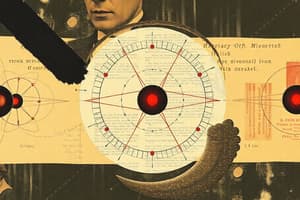Podcast
Questions and Answers
What is a pure substance?
What is a pure substance?
- An element (correct)
- A mixture of two elements
- A mixture of two compounds
- A compound (correct)
What is a compound?
What is a compound?
- A single type of atom
- A mixture of two compounds
- A mixture of elements
- Two or more elements chemically combined (correct)
What is a mixture?
What is a mixture?
- One type of atom
- A compound
- Two or more substances (correct)
- A pure substance
What is an element?
What is an element?
Flashcards are hidden until you start studying
Study Notes
Pure Substances
- Defined as materials with a constant composition, consisting of a single type of particle.
- Types include elements and compounds.
Compound
- A pure substance formed by the chemical combination of two or more different elements.
- Examples include water (H₂O) and carbon dioxide (CO₂).
Element
- The simplest form of pure substance that consists of only one type of atom.
- Examples include oxygen (O) and gold (Au).
Mixture
- Composed of two or more substances that are not chemically bonded.
- Can be heterogeneous (different compositions) or homogeneous (uniform composition).
Types of Mixtures
- Mixtures can include combinations of elements and compounds:
- Mixture of two compounds involves different chemical formulas without reaction.
- A mixture of one compound and two elements consists of a compound and additional elemental materials.
- Mixture of two elements involves two different types of atoms without forming a compound.
Key Definitions Recap
- Pure Substance: Constant composition, includes compounds and elements.
- Compound: Chemically bonded elements.
- Element: Single kind of atom, cannot be broken down.
- Mixture: Physical combination of substances, retain individual properties.
Studying That Suits You
Use AI to generate personalized quizzes and flashcards to suit your learning preferences.




